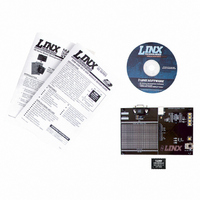MDEV-USB-QS Linx Technologies Inc, MDEV-USB-QS Datasheet - Page 2

MDEV-USB-QS
Manufacturer Part Number
MDEV-USB-QS
Description
KIT DEV MASTER USB QS SERIES
Manufacturer
Linx Technologies Inc
Series
QSr
Type
USBr
Datasheet
1.MDEV-USB-QS.pdf
(7 pages)
Specifications of MDEV-USB-QS
Supply Voltage (min)
7 V
Product
RF Development Tools
Supply Voltage (max)
16 V
Lead Free Status / RoHS Status
Contains lead / RoHS non-compliant
For Use With/related Products
QS Series
Lead Free Status / Rohs Status
Lead free / RoHS Compliant
MDEV-USB-QS DEVELOPMENT BOARD
Figure 1: The QS Series Development Board
1.
2.
3.
4.
5.
6.
7.
8.
9.
10.
11.
12.
Page 2
DB9 Connector
RS-232 Level Converter Chip
Prototyping Area
Breakout Header
USB Jack
QS Module
Modem Line Buttons
Modem Line LEDs
Microcontroller
Microcontroller LEDs
Microcontroller Button
Voltage Adjust Potentiometer
3
1
2
4
5
10
6
9
8
12
11
7
GETTING STARTED
USB AREA
Figure 2: USB Area
Figure 3: Software Modem Line Section
There are four areas on the development board: the USB area, the RS-232 area,
the Microcontroller area, and the Prototyping area. The RS-232 area connects
the QS module to a standard DB9 serial connector through a RS-232 level
converter chip. This section allows for full handshaking so that a legacy device
can be connected and tested. The microcontroller section connects the QS to a
Microchip PIC microcontroller. The included software demonstrates how to
interface the QS to the PIC for bi-directional communication with a custom
processor. Much of the source code is documented in the software’s help file and
provides a good foundation upon which to build a custom product.
This section demonstrates how to activate the modem outputs and read the
modem inputs. Figure 2 shows the development board and Figure 3 shows the
Modem Line section in the development software.
Pressing the RTS and DTR buttons in the application software will activate the
RTS and DTR LEDs on the development board. Pressing the RI, DCD, DSR, or
CTS buttons on the board will cause the appropriate indicator on the software
screen to light up. The source code for programming this can be found in the
software’s Help File.
There are two LEDs to the left of the module, one marked TX IND and another
marked RX IND. These will flash when the module is sending and receiving data,
respectively.
Note that the modem lines are designed to work with UARTs, so the states are
inverted. This means that the lines are at V
CC
when off and at ground when on.
Page 3



















